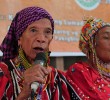By CHERYLL D. FIEL | Davao Today

Nepthalie Betito explains the making of a catchment for rainwater they use to water their vegetable garden in the dry summer. (davaotoday.com photo by Cheryll D. Fiel)
Growing plants in the summer could be very difficult, especially for farmers in Mindanao more prone to the risks of temperature increase.
According to the Manila Observatory, a non-government organization which has been into scientific research on atmospheric science, it is Mindanao which poses high risk to temperature increase and El Ni�o.
Based on risk maps which the Manila Observatory issued recently and which can be viewed at www.observatory.ph/vm, 16 areas in Mindanao are in the top twenty areas considered high risk to temperature increase.
Davao del Sur, which ranked sixth in the risk map is considered to be more at risk from El Ni�o and Davao del Norte, 18th.

A neighbour of the Betito’s hauls water from the cistern. (davaotoday.com photo by Cheryll D. Fiel)
But who knows, the practice of farmers in Panay’s oldest municipality of Oton could help Mindanao farmers cope with the harsh weather?
In Sta. Monica, a village in the coastal town of Oton, where participants in the Iloilo city disaster risk reduction reporting training visited, irrigation canals are all drying up at this time of the year.
Only the family of Jose Gerry Mansili and some neighbours can make use of the land because of a pond, half-a-hectare wide, they built twenty years ago.
The pond serves as catchment for rainwater used to irrigate their rice field in summer. The family also grows hito and tilapia in the pond.

Summer Harvest. The Betito’s still get to harvest vegetables from their garden even at the height of summer, when almost every plant in the area seems to have wilted and died. Thanks to the cisterns that collect rainwater they use to irrigate their plants. (davaotoday.com photo by Cheryll D. Fiel)
In barangay Abilay Sur, not far from Sta. Monica, Nepthalie Betito does not have land as big as the Mansili’s but Betito was able to find a way.
He dug out a pit four meters deep and three meters wide and with improvised bamboo to serve as pipelines, collected rain water from the rooftops to the pit. His wife helped him dig another two of this pit.
So, when the last of the rains came in February this year, Betito had already collected enough rainwater in these cisterns to irrigate his plants throughout the summer.
Betito once tried to find a better life out of Iloilo, working for various odd jobs, which included being a sales agent for books in Davao.
Finding no luck in these ventures, he returned to Iloilo five years ago. He found himself in possession of a land that totally dries up and cracks up in summer.










